
The Jewish view on marriage, historically, provided Biblically mandated rights to the wife which were accepted by the husband. A marriage was ended either because of a divorce document given by the man to his wife, or by the death of either party. Certain details, primarily as protections for the wife, were added in Talmudic times.
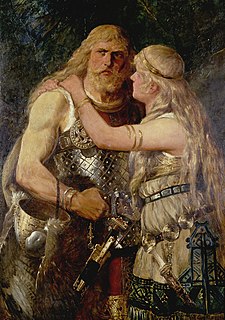
Marriage, also called matrimony or wedlock, is a culturally recognised union between people, called spouses, that establishes rights and obligations between them, as well as between them and their children, and between them and their in-laws. It is considered a cultural universal, but the definition of marriage varies between cultures and religions, and over time. Typically, it is an institution in which interpersonal relationships, usually sexual, are acknowledged or sanctioned. In some cultures, marriage is recommended or considered to be compulsory before pursuing any sexual activity. A marriage ceremony is called a wedding.

An engagement or betrothal is the period of time between a marriage proposal and the marriage itself. During this period, a couple is said to be fiancés, betrothed,intended, affianced, engaged to be married, or simply engaged. Future brides and grooms may be called fiancée (feminine) or fiancé (masculine), the betrothed, a wife-to-be or husband-to-be, respectively. The duration of the courtship varies vastly, and is largely dependent on cultural norms or upon the agreement of the parties involved.

Traditional Chinese marriage is a ceremonial ritual within Chinese societies that involves not only a union between spouses, but also a union between the two families of a man and a woman, sometimes established by pre-arrangement between families. Marriage and family are inextricably linked, which involves the interests of both families. Within Chinese culture, romantic love and monogamy was the norm for most citizens. Around the end of primitive society, traditional Chinese marriage rituals were formed, with deer skin betrothal in the Fuxi era, the appearance of the "meeting hall" during the Xia and Shang dynasties, and then in the Zhou dynasty, a complete set of marriage etiquette gradually formed. The richness of this series of rituals proves the importance the ancients attached to marriage. In addition to the unique nature of the "three letters and six rituals", monogamy, remarriage and divorce in traditional Chinese marriage culture are also distinctive.
Lobola or Lobolo in Zulu, Swazi, Xhosa, Silozi and northern and southern Ndebele, and Mamalo in Tshivenda language, sometimes referred to as "bride wealth" is property in livestock or kind, which a prospective husband or head of his family undertakes to give to the head of a prospective wife’s family in gratitude of letting the husband marry their daughter.
Arranged marriage is a tradition in the societies of the Indian subcontinent, and continue to account for an overwhelming majority of marriages in the Indian subcontinent. Despite the fact that romantic love is "wholly celebrated" in both Indian mass media and folklore, and the arranged marriage tradition lacks any official legal recognition or support, the institution has proved to be "surprisingly robust" in adapting to changed social circumstances and has defied predictions of decline as India modernized.
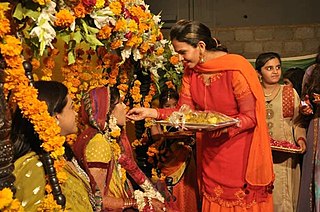
Marriage in Pakistan pertains to wedding traditions established and adhered by Pakistani men and women. Despite their local and regional variations, marriages in Pakistan generally follow Islamic marital jurisprudence. Culturally, marriages are not only seen as a union between a husband and a wife, but also an alliance between their respective families. These traditions extend to other countries around in the world where Overseas Pakistani communities exist.
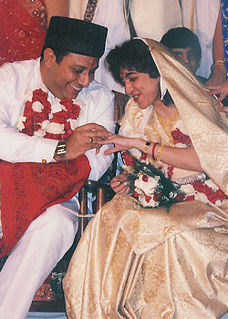
Zoroastrian weddings are a religious ceremony in Zoroastrianism in which two individuals, a man and a woman are united. In Zoroastrianism, marriage within the community is encouraged, and is greatly favored in religious texts. The following information will detail ceremony procedures and traditional processes for a Zoroastrian wedding.
The increasing number of Asian migrant brides in Japan marrying Japanese men is a phenomenon occurring in both rural and urban Japan. Since the mid 1980s, rural Japanese men have begun taking foreign Asian brides, from the Philippines, Sri Lanka, Thailand, China and South Korea, as a way of compensating for the reduced number of Japanese women of marriageable, childbearing age who are willing to marry rural Japanese men. The phenomenon later spread to urban parts of Japan as well. The phenomenon has created a new industry of foreign marriage brokering that uses both local governments and private organizations to facilitate the immigration of foreign brides. This is largely a result of an aging population in Japan where approximately 20% of the population is over the age of 65, which is exceptionally high, a fertility rate of only 1.3, and increased opportunities for women and increased costs in child care.
In Chinese tradition, a ghost marriage is a marriage in which one or both parties are deceased. Other forms of ghost marriage are practiced worldwide, notably in France since 1959. The origins of Chinese ghost marriage are largely unknown, but reports of it being practiced today can still be found.
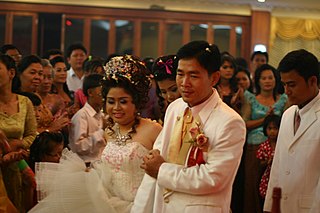
Courtship, marriage, and divorce in Cambodia are important aspects of family life. Customs vary as between rural and urban areas, with many city dwellers being influenced by western ideas. The choice of a spouse is usually undertaken by the families of young men and women, sometimes with the help of a matchmaker. A man usually marries between the ages of nineteen and twenty-five and a girl between sixteen and twenty-two.
The matrimonial law of Singapore categorizes marriages contracted in Singapore into two categories: civil marriages and Muslim marriages. The Registry of Marriage (ROM) administers civil marriages in accordance to the Women's Charter, while the Registry of Muslim Marriages (ROMM) administers Muslim marriages in accordance to the Administration of Muslim Law Act (AMLA). All marriages performed in Singapore must be registered with the relevant registry in order to be legally valid.
Weddings in the United States follow traditions often based on religion, culture, and social norms. Most wedding traditions in the United States were assimilated from other, generally European, countries. Marriages in the U.S. are typically arranged by the participants and ceremonies may either be religious or civil. There is a tradition that the prospective bridegroom ask his future father-in-law for his blessing.

Marriage in China has undergone change during the country's reform and opening period, especially as a result of new legal policies such as the New Marriage Law of 1950 and the Family planning policy in place from 1979 to 2015. The major transformation in the twentieth century is characterized by the change from traditional structures for Chinese marriage, such as the arranged marriage, to one where the freedom to choose one’s partner is generally respected. However, both parental and cultural pressures are still placed on many individuals, especially women, to choose socially and economically advantageous marriage partners. While divorce remains rare in China, the 1.96 million couples applying for divorce in 2010 represented a rate 14% higher than the year before and doubled from ten years ago. Despite this rising divorce rate, heterosexual marriage is still thought of as a natural part of the life course and as a responsibility of good citizenship in China.

Marriage in Japan is a legal and social institution at the center of the household. Couples are legally married once they have made the change in status on their family registration sheets, without the need for a ceremony. Most weddings are held either according to Shinto traditions or in chapels according to Christian marriage traditions.
Vietnamese migrant brides in Taiwan represent marriages between Taiwanese men and Vietnamese brides who are mostly from poor, rural areas of Vietnam, such as those along the Mekong Delta. As of 2006, out of Taiwan’s immigrant population of approximately 428,240 people, 18% were females who had relocated to the country through marriage. Out of this population, about 85% originated from the Southeast Asian countries of Vietnam, Indonesia, Thailand, and Philippines, with the majority hailing from Vietnam. It is estimated that between the years of 1995 and 2003, the number of Vietnamese women married to Taiwanese men increased from 1,476 to more than 60,000 individuals, making the Vietnamese the largest non-Chinese immigrant group living in the island. This event has been seen locally and abroad as something that can potentially evolve into a concerning societal and humanitarian issue. This issue is not just localised in Taiwan but also in Southern China provinces
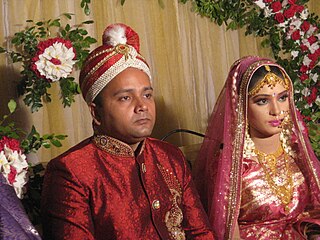
Muslim marriage and Islamic wedding customs are traditions and practices that relate to wedding ceremonies and marriage rituals prevailing within the Muslim world. Although Islamic marriage customs and relations vary depending on country of origin and government regulations, both Muslim men and women from around the world are guided by Islamic laws and practices specified in the Quran.

Bride price, bridewealth, or bride token, is money, property, or other form of wealth paid by a groom or his family to the woman or the family of the woman he will be married to or is just about to marry. Bride price can be compared to dowry, which is paid to the groom, or used by the bride to help establish the new household, and dower, which is property settled on the bride herself by the groom at the time of marriage. Some cultures may practice both dowry and bride price simultaneously. Many cultures practiced bride pricing prior to existing records.

In the nation of Myanmar (Burma), certain customs are associated with the institution of marriage.
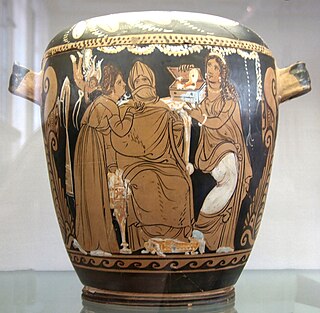
Marriage in ancient Greece had less of a basis in personal relationships and more in social responsibility. The goal and focus of all marriages was intended to be reproduction, making marriage an issue of public interest. Marriages were usually arranged by the parents; on occasion professional matchmakers were used. Each city was politically independent and each had its own laws concerning marriage. For the marriage to be legal, the woman's father or guardian gave permission to a suitable male who could afford to marry. Orphaned daughters were usually married to uncles or cousins. Wintertime marriages were popular due to the significance of that time to Hera, the goddess of marriage. The couple participated in a ceremony which included rituals such as veil removal, but it was the couple living together that made the marriage legal. Marriage was understood to be the official transition from childhood into adulthood for females.

















